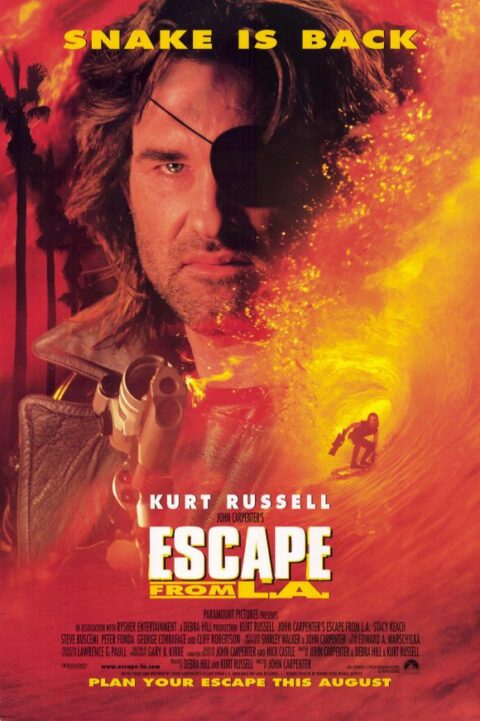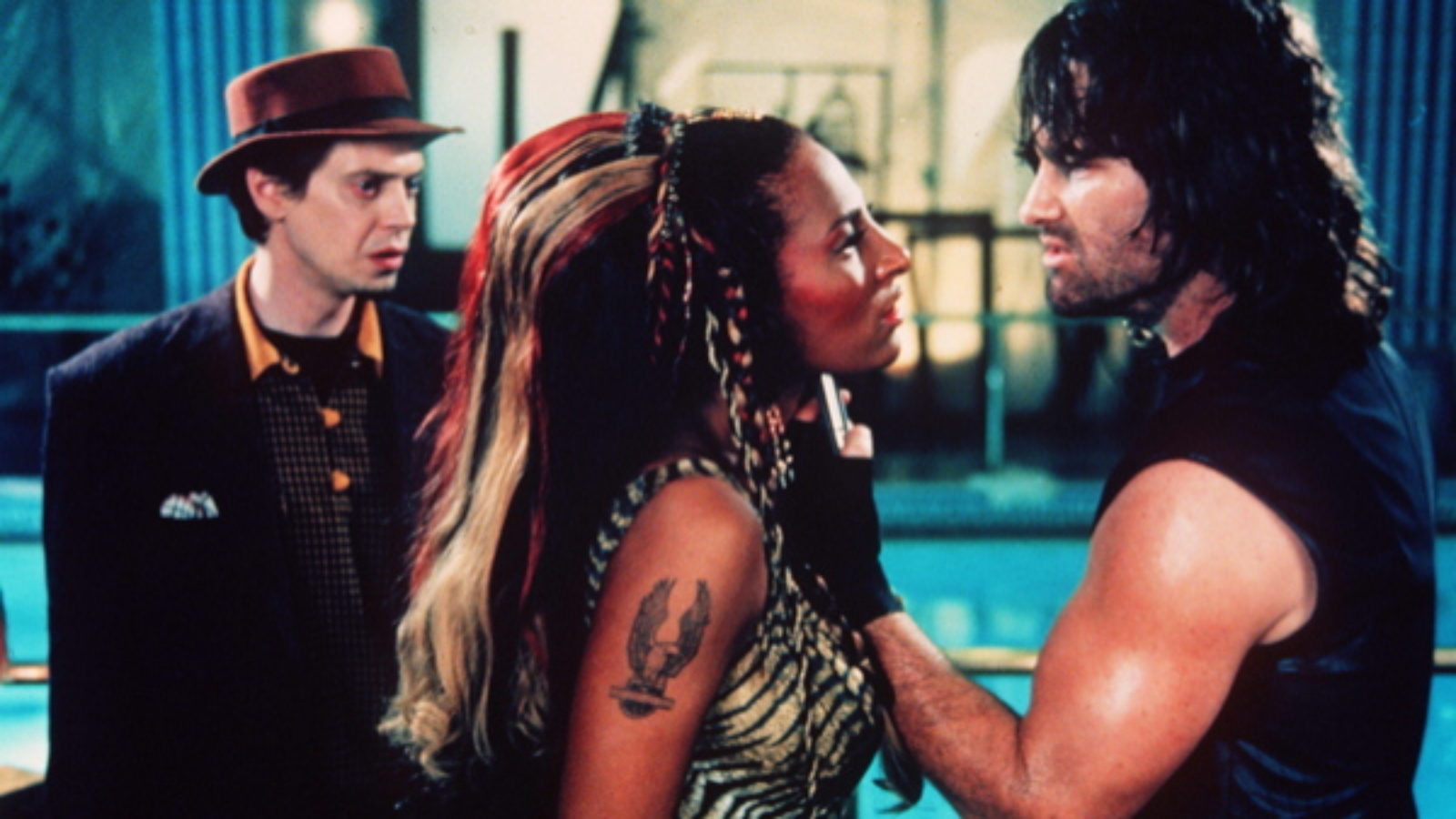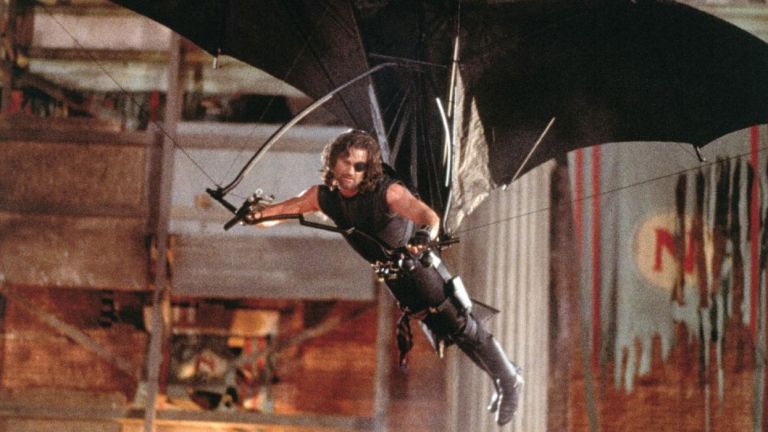 John Carpenter’s ersatz sequel (remake, actually) to his 1981 hit ESCAPE FROM NEW YORK, reuniting him with that film’s late producer Debra Hill (1950-2005) and its star Kurt Russell (who received co-producer and screenwriting credits). It was, as it turned out, Russell’s final collaboration with Carpenter (others included ELVIS, THE THING and BIG TROUBLE IN LITTLE CHINA), and, at $50 million (a massive increase from ESCAPE FROM NEW YORK’S $6 million price tag), the most highly budgeted film of Carpenter’s career. Unfortunately its August, 1996 release only returned half that budget.
John Carpenter’s ersatz sequel (remake, actually) to his 1981 hit ESCAPE FROM NEW YORK, reuniting him with that film’s late producer Debra Hill (1950-2005) and its star Kurt Russell (who received co-producer and screenwriting credits). It was, as it turned out, Russell’s final collaboration with Carpenter (others included ELVIS, THE THING and BIG TROUBLE IN LITTLE CHINA), and, at $50 million (a massive increase from ESCAPE FROM NEW YORK’S $6 million price tag), the most highly budgeted film of Carpenter’s career. Unfortunately its August, 1996 release only returned half that budget.
If nothing else, ESCAPE FROM L.A. conclusively demonstrates just how dramatically nineties cinema has dated—although, speaking as one who went to see it back in ‘96, I can attest that it always seemed tacky and, in its smirkily ironic (read: Tarantino-esque) tone, inappropriate. The one saving grace is a gonzo thrust that far outdoes ESCAPE FROM NEW YORK. The fact that ESCAPE FROM L.A. is set in the city that Carpenter, Hill, and Russell all called home appears to have served as a renewed source of inspiration for everyone involved. It’s a shame Carpenter wasn’t able to do that inspiration justice.
Snake Plissken (Russell) is a criminal who in the year 2013, despite having saved the President of the United States’ life several years earlier, is being transported to a maximum security prison in Los Angeles. Yet, as in ESCAPE FROM NEW YORK, Snake is given a possible respite: if he can infiltrate a Hispanic gang harboring the ne’er do well daughter (A.J. Langer) of the current President (Cliff Robertson) and steal a doomsday device in her possession, he’ll be freed. That entails entering Los Angeles, has been rendered a dangerous wasteland after a massive late-nineties earthquake. To make sure he doesn’t welch on the deal Snake has been infected with a designer virus set to end his life in ten hours, with an antidote promised when he returns.

Snake does as promised, entering the city (filmed largely in Florida and Texas) via an underwater pod, and quickly tracking down the gang. In so doing he encounters many LA-centric elements, such as an aging surfer (Peter Fonda) who’s still looking for the Perfect Wave, a hospital in which victims of plastic surgery gone bad are imprisoned, a basketball court-coliseum in which gangbangers force their “gladiators” to shoot hoops, and a treadmill torture device. Snake, being the badass he is, manages to overcome them all, and in the process gain several allies—all of whom get killed before his journey is done.
The film critic/documentarian Kent Jones, writing in the January/February 1999 issue of FILM COMMENT, dubbed John Carpenter “an analog man in a digital world.” To understand precisely what Jones meant one need only view ESCAPE FROM L.A. Carpenter, working with several of his 1980s collaborators (including cinematographer Gary B. Kibbe and editor Edward A. Warschilka), contributes highly static-y action sequences, with languid cutting that makes sure to include reaction shots even in the midst of fight and car chases (in which none of the vehicles ever go very fast). It’s all extremely well-lit, despite being set entirely at night (and in an environ where electricity is nonexistent).

The digital effects are quite copious, which is another problem, as CGI was still in its infancy in 1996. To add further insult, those effects were paired with painted mattes, an old timey movie device that’s no longer in use (with good reason). Not even the music by Carpenter, who offers a grunge-fueled updating of his minimalistic ESCAPE FROM NEW YORK score, offers much in the way of edification.
Kurt Russell is game as the eternally badass Snake Plissken, even if his hissing delivery quickly grows tiresome, and Steve Buscemi, playing his standard nineties role of a weaselly criminal (also on display in films ranging from RESERVOIR DOGS to THINGS TO DO IN DENVER WHEN YOU’RE DEAD), is also quite memorable. The rest of the cast, stocked with dependable actors like Cliff Robertson, Stacey Keach, Robert Carradine, Valeria Golino, Paul Bartel, and Bruce Campbell, is merely adequate, although mention must be made of Pam Grier in a juicy role as a transsexual gang leader (with electronically enhanced vocals), a year prior to her “comeback” role in JACKIE BROWN.
Vital Statistics
ESCAPE FROM L.A.
Paramount
Director: John Carpenter
Producers: Debra Hill, Kurt Russell
Screenplay: John Carpenter, Debra Hill, Kurt Russell
Cinematography: Gary B. Kibbe
Editing: Edward A. Warschilka
Cast: Kurt Russell, A.J. Langer, Steve Buscemi, George Corraface, Stacy Keach, Michelle Forbes, Pam Grier, Jeff Imada, Cliff Robertson, Valeria Golino, Peter Fonda, In Romeo, Peter Jason, Jordan Baker, Caroleen Feeney, Paul Bartel, Tom McNulty, Bruce Campbell, Breckin Meyer, Robert Carradine, Shelly Desai, Leland Orser
